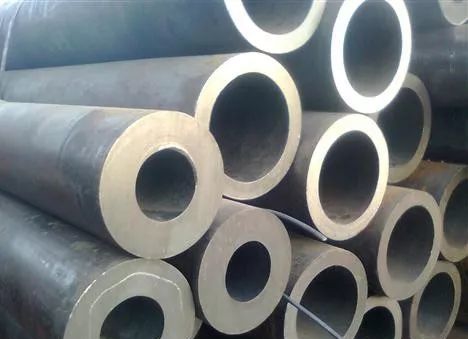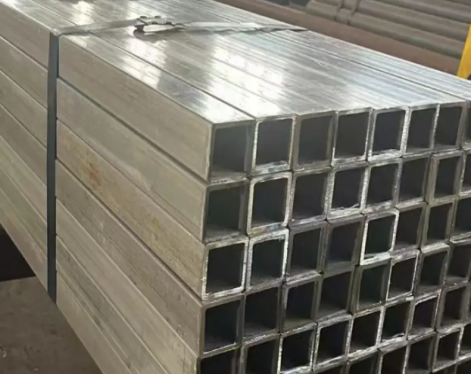Hydrogen embrittlement is usually manifested as a significant decrease in the plasticity of steel, a sharp increase in brittleness, and a tendency to rupture after a period of time under static load (often lower than the σb of the material).
Generally speaking, there are three main factors that affect the hydrogen embrittlement fracture of seamless pipes:
1)Envirnmental factor
When steel is in an environment with high hydrogen content, such as water, acid, and hydrogen, hydrogen diffuses through adsorption on the steel surface, causing the steel to become brittle. At the same time, the hydrogen partial pressure has a significant effect on the hydrogen crack growth rate, and increasing the hydrogen pressure will increase the hydrogen embrittlement sensitivity.
2)Strength factor
In general, the higher the strength of the steel, the greater the susceptibility to hydrogen embrittlement. Some countries expressly stipulate that "high-strength steel is not allowed to pickle" to prevent hydrogen embrittlement. The chemical composition affects the hydrogen embrittlement fracture of steel through strength. This is because the segregation of hydrogen and S, P and other atoms at the grain boundary will weaken the bonding force of the grain boundary, thereby promoting the first fracture along the grain boundary.
3)Heat treatment
The hydrogen embrittlement of steel is closely related to its microstructure and heat treatment. Experiments and facts show that the worse the thermodynamic stability of the structure, the greater the sensitivity of hydrogen embrittlement. For example, the hydrogen embrittlement tendency of pearlite and ferrite is much lower than that of martensite, and the high-carbon martensite with network distribution is the most sensitive.

Measures to prevent hydrogen embrittlement
The study shows that directly carrying out the electrochemical measurement of hydrogen permeation is a feasible method to study the hydrogen permeation behavior during the pickling process under the pickling condition. In order to reduce the degree of hydrogen permeation of steel parts, the following measures can be taken to prevent hydrogen permeation.
1)Introduces multifunctional slow suppression. The multifunctional inhibitor has the functions of corrosion inhibition and fog inhibition, not only the pickling speed is fast, but also the function of inhibiting hydrogen permeation is strong, and the corrosion inhibition rate is high.
2)Control the pickling conditions. The amount of hydrogen permeation of steel in the pickling solution has little relationship with the acidity, but it is proportional to the pickling temperature and the square root of the pickling time. It is recommended to use a method with a relatively high acid concentration and a short pickling time.Pickling of high-strength steels such as high-speed steel quenched parts should pay more attention to this problem. The specific production unit should formulate a rigorous process, and control the three elements of acid concentration, acid temperature, and pickling time.
3)Focus on stress corrosion problems. Stress corrosion cracking refers to the process in which the workpiece is subjected to the combined action of static tensile stress and a specific corrosive environment, resulting in brittle cracking of materials. The straightened quenched parts, whether it is a frontal strike or a counterattack, all straightened workpieces must be de-stressed and then pickled, to deny the probability of hydrogen embrittlement cracking or embrittlement.
4)Prevent metal impurities from contaminating the pickling solution. It has been found out that when the pickling solution contains P, As, Sn, Hg, Pb, Zn, Cd and other metal impurities, it will promote the increase of hydrogen permeation and aggravate the tendency of hydrogen embrittlement fracture.
5)Hydrogen treatment. After the pickling process, it is best to carry out the hydrogen flooding treatment at 180~200℃×3~4h
Generally speaking, there are three main factors that affect the hydrogen embrittlement fracture of seamless pipes:
1)Envirnmental factor
When steel is in an environment with high hydrogen content, such as water, acid, and hydrogen, hydrogen diffuses through adsorption on the steel surface, causing the steel to become brittle. At the same time, the hydrogen partial pressure has a significant effect on the hydrogen crack growth rate, and increasing the hydrogen pressure will increase the hydrogen embrittlement sensitivity.
2)Strength factor
In general, the higher the strength of the steel, the greater the susceptibility to hydrogen embrittlement. Some countries expressly stipulate that "high-strength steel is not allowed to pickle" to prevent hydrogen embrittlement. The chemical composition affects the hydrogen embrittlement fracture of steel through strength. This is because the segregation of hydrogen and S, P and other atoms at the grain boundary will weaken the bonding force of the grain boundary, thereby promoting the first fracture along the grain boundary.
3)Heat treatment
The hydrogen embrittlement of steel is closely related to its microstructure and heat treatment. Experiments and facts show that the worse the thermodynamic stability of the structure, the greater the sensitivity of hydrogen embrittlement. For example, the hydrogen embrittlement tendency of pearlite and ferrite is much lower than that of martensite, and the high-carbon martensite with network distribution is the most sensitive.

Measures to prevent hydrogen embrittlement
The study shows that directly carrying out the electrochemical measurement of hydrogen permeation is a feasible method to study the hydrogen permeation behavior during the pickling process under the pickling condition. In order to reduce the degree of hydrogen permeation of steel parts, the following measures can be taken to prevent hydrogen permeation.
1)Introduces multifunctional slow suppression. The multifunctional inhibitor has the functions of corrosion inhibition and fog inhibition, not only the pickling speed is fast, but also the function of inhibiting hydrogen permeation is strong, and the corrosion inhibition rate is high.
2)Control the pickling conditions. The amount of hydrogen permeation of steel in the pickling solution has little relationship with the acidity, but it is proportional to the pickling temperature and the square root of the pickling time. It is recommended to use a method with a relatively high acid concentration and a short pickling time.Pickling of high-strength steels such as high-speed steel quenched parts should pay more attention to this problem. The specific production unit should formulate a rigorous process, and control the three elements of acid concentration, acid temperature, and pickling time.
3)Focus on stress corrosion problems. Stress corrosion cracking refers to the process in which the workpiece is subjected to the combined action of static tensile stress and a specific corrosive environment, resulting in brittle cracking of materials. The straightened quenched parts, whether it is a frontal strike or a counterattack, all straightened workpieces must be de-stressed and then pickled, to deny the probability of hydrogen embrittlement cracking or embrittlement.
4)Prevent metal impurities from contaminating the pickling solution. It has been found out that when the pickling solution contains P, As, Sn, Hg, Pb, Zn, Cd and other metal impurities, it will promote the increase of hydrogen permeation and aggravate the tendency of hydrogen embrittlement fracture.
5)Hydrogen treatment. After the pickling process, it is best to carry out the hydrogen flooding treatment at 180~200℃×3~4h









